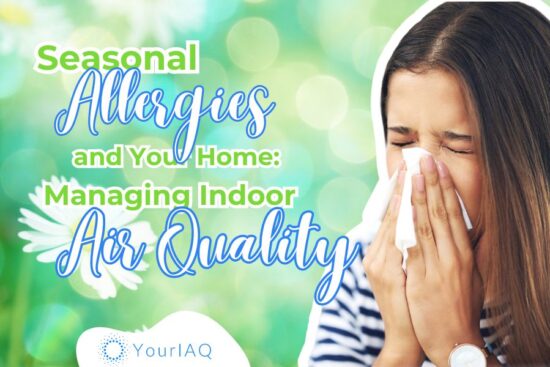Indoor air quality is an increasingly important issue with respect to human health and well-being. Understanding and improving indoor air quality is crucial to reduce illness, increase productivity, and ensure safe living and working environments. Here, we address some of the most Frequently Asked Questions about indoor air quality.
Indoor air quality is the condition of the air in an indoor space, specifically in terms of the presence and concentration of pollutants, gases, and other air particles. Indoor air quality is a measure of the health and safety of the air you breathe indoors. Factors that influence indoor air quality include humidity, temperature, air pressure, and the presence of pollutants. These pollutants include particulate matter, VOCs, carbon monoxide, smoke, and biological pollutants. The presence of such contaminants can have adverse effects on your health and the property itself. Monitoring indoor air quality is important to ensure that the air you breathe is safe and free from dangerous pollutants.
More pollutants mean lower air quality. When you breathe air contaminated by harmful chemicals and carcinogens, especially over a prolonged period of time, it increases the risk of contracting an illness or developing symptoms of respiratory disease, asthma, or allergies.
Globally, the world health organization attributes more than 3 million deaths annually to low indoor air quality. While most of these occur in places with high levels of poverty and poor infrastructure, indoor air quality issues cause or exacerbate tens of thousands of injuries and sicknesses in the U.S. alone each year. It’s difficult to fully measure the impact because breathing poor air tends to contribute to countless other problems including worsening health conditions, increasing medical and insurance costs, and harming the environment. It’s safe to say that indoor air quality is a huge issue.
We spend more than 90% of our time indoors, and take more than 20,000 breaths per day. That’s why indoor air quality is actually more likely to cause sickness than outdoor air pollution. The most common health issues associated with poor indoor air quality are asthma, heightened allergies, respiratory disease, and heart and lung illnesses. Depending on the pollutant, the issues can be life threatening. For example, radon causes about 20,000 cases of lung cancer each year according to the EPA. Carbon monoxide poisoning sends 100,000 people to the emergency room annually. These numbers don’t begin to take into account things like loss of sleep, headaches, nausea, and other side effects of breathing bad air that contribute to massive productivity losses and low quality of life.
The US EPA has an Indoor Environments Division that provides guidance and programs to support communities in developing better air quality. There are a number of other federal departments that contribute resources toward safer, healthier infrastructure, housing, and workplace development. They include OSHA, HUD, CDC, and the NIH.
Presently there is no national standard for indoor air quality. There is a standardized system regulated by the EPA called the AQI (air quality index) that measures and communicates outdoor air quality levels around the country to the public. The AQI uses air quality monitors in various outdoor locations to measure pollutant levels, and generally reports on standard levels of particulate matter, ozone, sulfur dioxide, nitrogen dioxide, and carbon monoxide. However, this index does not measure indoor air quality. Indoor air quality is highly variable across indoor spaces. While it is often influenced by outdoor air, indoor air quality levels can be substantially different between two buildings right next door to each other.
Indoor air quality has implications across society, from public health policy, to environmental sustainability, from building regulations, to macroeconomic impact. Healthier air means healthier people and a healthier environment. This means more productivity, lower costs of insurance and healthcare, and higher quality of life for millions of people.
Outdoor air quality influences indoor air quality in a number of ways. For example, wildfires can threaten indoor air with ash and particulate matter that find their way into indoor ventilation. Unseasonably warm weather, humidity, or elevated pollen counts can contribute to higher levels of biological pollutants and mold inside buildings. But indoor air quality can be controlled much more effectively than outdoor air, particularly with the use of air filters, management of air circulation, fans, and air purification systems.
Indoor air quality is best measured using air quality monitors with sensor technology. Specialized equipment with air sensors collect data on size, concentration, and volume of varying types of air particles and can make accurate readings of whether or not air quality poses a potential threat to your health. Most buildings have had smoke and carbon monoxide detectors for decades. Modern sensor tech provides the ability to go well beyond these contaminants and collect information on dozens of additional air quality factors.
The first step is knowing what you’re dealing with. To improve your air, you first have to monitor it and understand which pollutants might be a threat to your home. The EPA recommends 3 basic strategies for improving indoor air quality:
- Control the source – find out where pollution is coming from and contain or stop it
- Ventilate – Find ways to circulate fresh air from outside. Open doors and windows, operate attic fans, or use window A/C units. If the source of poor air is external, take steps to seal the home and recirculate indoor air.
- Clean the air – There are many products on the market that can clean, purify, or dehumidify your air. Research the best product for your needs, including using the EPA’s guide to air cleaners in the home.
This is a common and easy tactic many people take to improve indoor air quality. Many indoor plants have been known to demonstrate air purifying qualities. Indoor plants can also contribute to a natural ambiance and appealing aesthetic. However, if you are experiencing high levels of harmful pollutants, the number of indoor plants you would need to make a noticeable impact is probably unrealistic. But they certainly can’t hurt.
As far as where low quality air comes from, there are generally two different sources: outdoor air and household products and activities. In terms of outdoor sources, wildfires, industrial pollution, motor vehicle combustion, and high pollen counts are the biggest culprits. Inside, the most dangerous air pollutants come from household chemicals such as aerosols, cleaning products, paint, and furnishings that emit VOCs, fumes from cooking or appliances, mold growth in damp locations, or waste and biological pollutants from pets and invasive animals and insects.
Like humans, pets also breathe indoor air. High levels of dangerous contaminants can create respiratory issues in dogs and cats and at worst contribute to the same kinds of irritations that people suffer from, including poor sleep, allergies, or low energy.
Managing indoor air quality starts with knowledge. Air quality monitors give you the ability to know what is in your indoor air and take corrective measures to change it. But beyond your immediate health and well being, as more people begin to use air quality monitors, more data will be collected. Ultimately that data, when anonymized and aggregated, can contribute to smarter public policy, inform building regulations, and help governments address weather and climate concerns.
Have an additional indoor air quality FAQ and don’t see it here? Send us a request.








